buttons Alfa Romeo 147 2005 Owner handbook (in English)
[x] Cancel search | Manufacturer: ALFA ROMEO, Model Year: 2005, Model line: 147, Model: Alfa Romeo 147 2005Pages: 291, PDF Size: 5.52 MB
Page 96 of 291
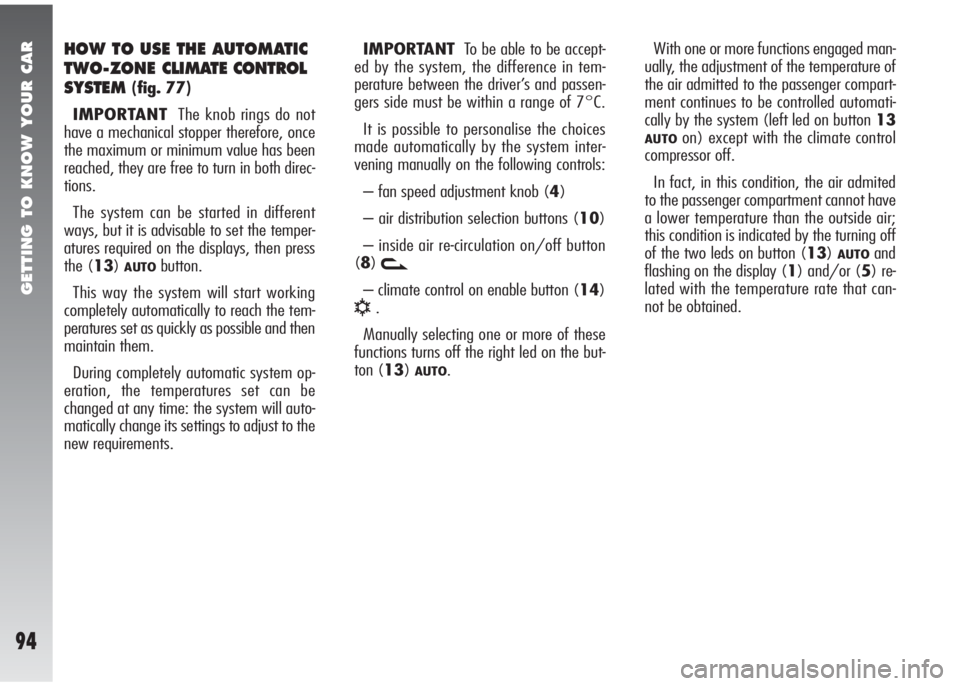
GETTING TO KNOW YOUR CAR
94
HOW TO USE THE AUTOMATIC
TWO-ZONECLIMATE CONTROL
SYSTEM
(fig. 77)
IMPORTANTThe knob rings do not
have a mechanical stopper therefore, once
the maximum or minimum value has been
reached, they are free to turn in both direc-
tions.
The system can be started in different
ways, but it is advisable to set the temper-
atures required on the displays, then press
the (13)
AUTObutton.
This way the system will start working
completely automatically to reach the tem-
peratures set as quickly as possible and then
maintain them.
During completely automatic system op-
eration, the temperatures set can be
changed at any time: the system will auto-
matically change its settings to adjust to the
new requirements.IMPORTANTTo be able to be accept-
ed by the system, the difference in tem-
perature between the driver’s and passen-
gers side must be within a range of 7°C.
It is possible to personalise the choices
made automatically by the system inter-
vening manually on the following controls:
– fan speed adjustment knob (4)
– air distribution selection buttons (10)
– inside air re-circulation on/off button
(8)v
– climate control on enable button (14)
√.
Manually selecting one or more of these
functions turns off the right led on the but-
ton (13)
AUTO.With one or more functions engaged man-
ually, the adjustment of the temperature of
the air admitted to the passenger compart-
ment continues to be controlled automati-
cally by the system (left led on button 13
AUTOon) except with the climate control
compressor off.
In fact, in this condition, the air admited
to the passenger compartment cannot have
a lower temperature than the outside air;
this condition is indicated by the turning off
of the two leds on button (13)
AUTOand
flashing on the display (1) and/or (5) re-
lated with the temperature rate that can-
not be obtained.
Page 102 of 291
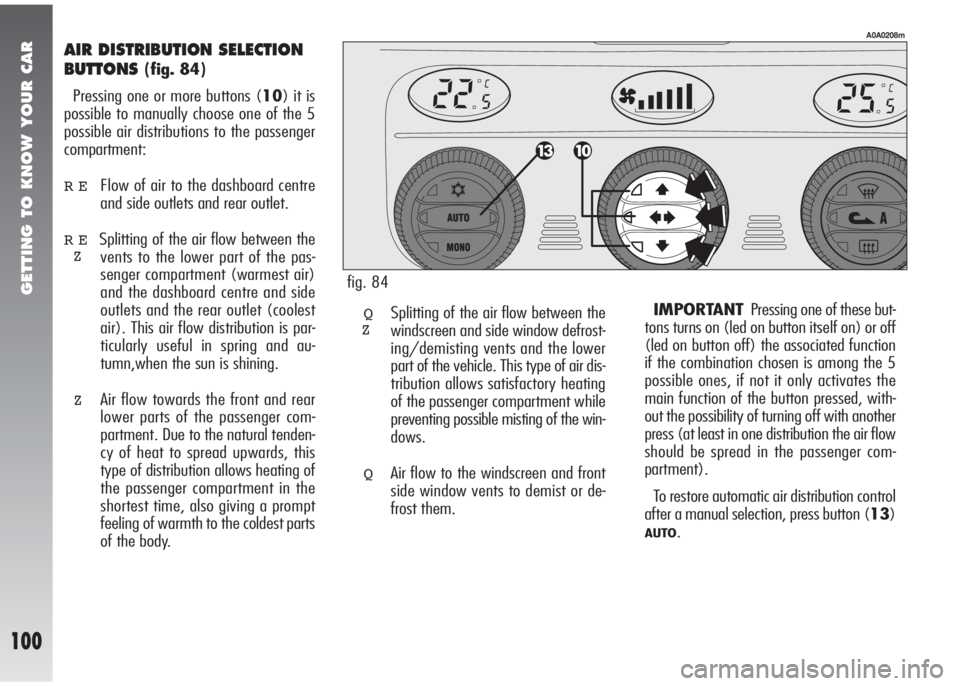
GETTING TO KNOW YOUR CAR
100
AIR DISTRIBUTION SELECTION
BUTTONS
(fig. 84)
Pressing one or more buttons (10) it is
possible to manually choose one of the 5
possible air distributions to the passenger
compartment:
REFlow of air to the dashboard centre
and side outlets and rear outlet.
RESplitting of the air flow between the
vents to the lower part of the pas-
senger compartment (warmest air)
and the dashboard centre and side
outlets and the rear outlet (coolest
air). This air flow distribution is par-
ticularly useful in spring and au-
tumn,when the sun is shining.
ZAir flow towards the front and rear
lower parts of the passenger com-
partment. Due to the natural tenden-
cy of heat to spread upwards, this
type of distribution allows heating of
the passenger compartment in the
shortest time, also giving a prompt
feeling of warmth to the coldest parts
of the body.
A0A0208m
QSplitting of the air flow between the
windscreen and side window defrost-
ing/demisting vents and the lower
part of the vehicle. This type of air dis-
tribution allows satisfactory heating
of the passenger compartment while
preventing possible misting of the win-
dows.
QAir flow to the windscreen and front
side window vents to demist or de-
frost them.IMPORTANTPressing one of these but-
tons turns on (led on button itself on) or off
(led on button off) the associated function
if the combination chosen is among the 5
possible ones, if not it only activates the
main function of the button pressed, with-
out the possibility of turning off with another
press (at least in one distribution the air flow
should be spread in the passenger com-
partment).
To restore automatic air distribution control
after a manual selection, press button (13)
AUTO.
Z
Z
fig. 84
Page 103 of 291
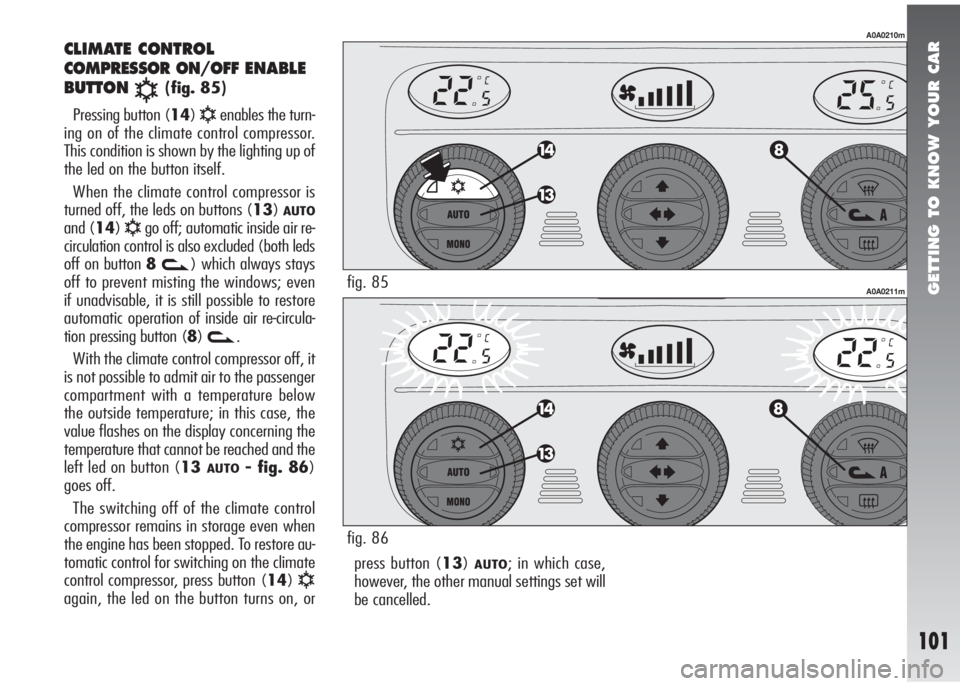
GETTING TO KNOW YOUR CAR
101
press button (13)AUTO; in which case,
however, the other manual settings set will
be cancelled.
CLIMATE CONTROL
COMPRESSOR ON/OFF ENABLE
BUTTON
√(fig. 85)
Pressing button (14)
√enables the turn-
ing on of the climate control compressor.
This condition is shown by the lighting up of
the led on the button itself.
When the climate control compressor is
turned off, the leds on buttons (13)
AUTO
and (14)√go off; automatic inside air re-
circulation control is also excluded (both leds
off on button 8
v) which always stays
off to prevent misting the windows; even
if unadvisable, it is still possible to restore
automatic operation of inside air re-circula-
tion pressing button (8)
v.
With the climate control compressor off, it
is not possible to admit air to the passenger
compartment with a temperature below
the outside temperature; in this case, the
value flashes on the display concerning the
temperature that cannot be reached and the
left led on button (13
AUTO- fig. 86)
goes off.
The switching off of the climate control
compressor remains in storage even when
the engine has been stopped. To restore au-
tomatic control for switching on the climate
control compressor, press button (14)
√again, the led on the button turns on, or
A0A0210m
A0A0211mfig. 85
fig. 86
Page 106 of 291
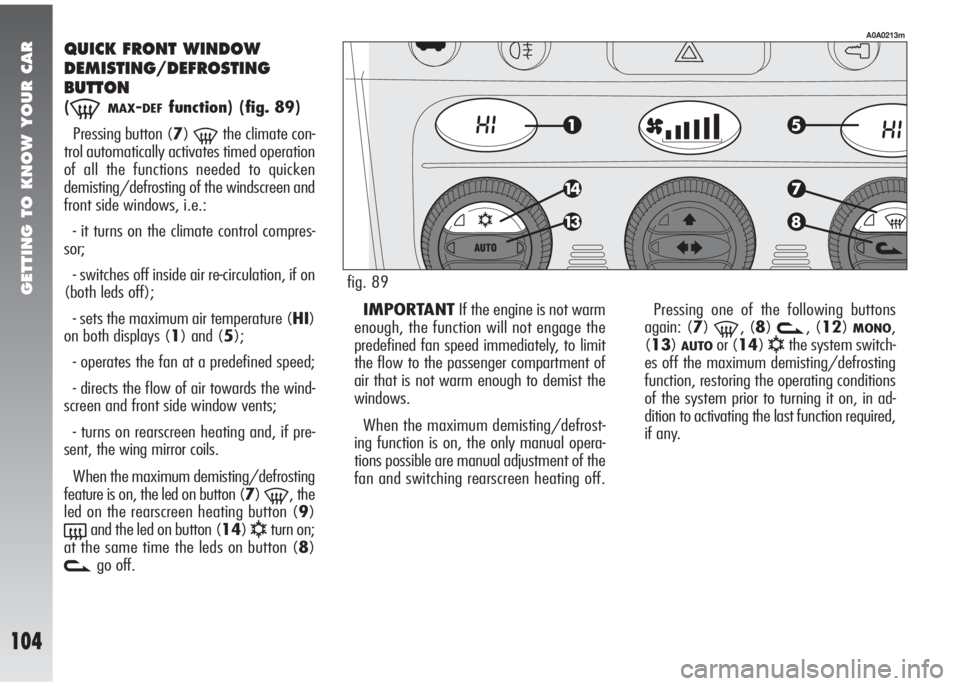
GETTING TO KNOW YOUR CAR
104
QUICK FRONT WINDOW
DEMISTING/DEFROSTING
BUTTON
(-MAX-DEFfunction)(fig. 89)
Pressing button (7)
-the climate con-
trol automatically activates timed operation
of all the functions needed to quicken
demisting/defrosting of the windscreen and
front side windows, i.e.:
- it turns on the climate control compres-
sor;
- switches off inside air re-circulation, if on
(both leds off);
- sets the maximum air temperature (HI)
on both displays (1) and (5);
- operates the fan at a predefined speed;
- directs the flow of air towards the wind-
screen and front side window vents;
- turns on rearscreen heating and, if pre-
sent, the wing mirror coils.
When the maximum demisting/defrosting
feature is on, the led on button (7)
-, the
led on the rearscreen heating button (9)
(and the led on button (14)√turn on;
at the same time the leds on button (8)
vgo off.IMPORTANTIf the engine is not warm
enough, the function will not engage the
predefined fan speed immediately, to limit
the flow to the passenger compartment of
air that is not warm enough to demist the
windows.
When the maximum demisting/defrost-
ing function is on, the only manual opera-
tions possible are manual adjustment of the
fan and switching rearscreen heating off.Pressing one of the following buttons
again: (7)
-, (8)v, (12)MONO,
(13)
AUTOor (14)√the system switch-
es off the maximum demisting/defrosting
function, restoring the operating conditions
of the system prior to turning it on, in ad-
dition to activating the last function required,
if any.
A0A0213m
fig. 89
Page 112 of 291
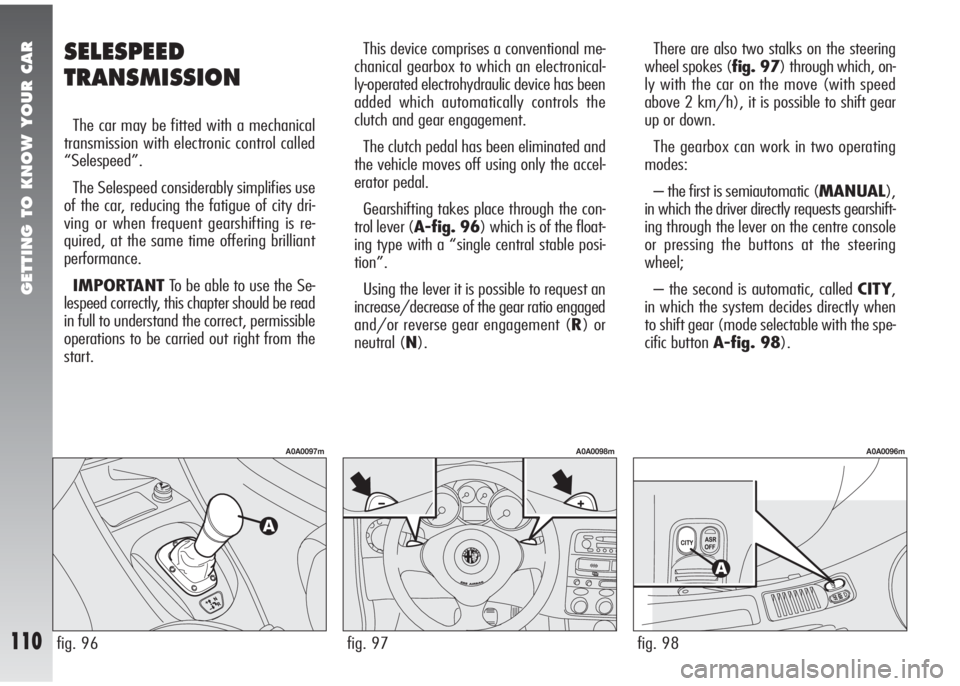
GETTING TO KNOW YOUR CAR
110
SELESPEED
TRANSMISSION
The car may be fitted with a mechanical
transmission with electronic control called
“Selespeed”.
The Selespeed considerably simplifies use
of the car, reducing the fatigue of city dri-
ving or when frequent gearshifting is re-
quired, at the same time offering brilliant
performance.
IMPORTANTTo be able to use the Se-
lespeed correctly, this chapter should be read
in full to understand the correct, permissible
operations to be carried out right from the
start.This device comprises a conventional me-
chanical gearbox to which an electronical-
ly-operated electrohydraulic device has been
added which automatically controls the
clutch and gear engagement.
The clutch pedal has been eliminated and
the vehicle moves off using only the accel-
erator pedal.
Gearshifting takes place through the con-
trol lever (A-fig. 96) which is of the float-
ing type with a “single central stable posi-
tion”.
Using the lever it is possible to request an
increase/decrease of the gear ratio engaged
and/or reverse gear engagement (R) or
neutral (N).There are also two stalks on the steering
wheel spokes (fig. 97) through which, on-
ly with the car on the move (with speed
above 2 km/h), it is possible to shift gear
up or down.
The gearbox can work in two operating
modes:
– the first is semiautomatic (MANUAL),
in which the driver directly requests gearshift-
ing through the lever on the centre console
or pressing the buttons at the steering
wheel;
– the second is automatic, called CITY,
in which the system decides directly when
to shift gear (mode selectable with the spe-
cific button A-fig. 98).
fig. 97
A0A0098m
fig. 98
A0A0096m
fig. 96
A0A0097m
Page 152 of 291
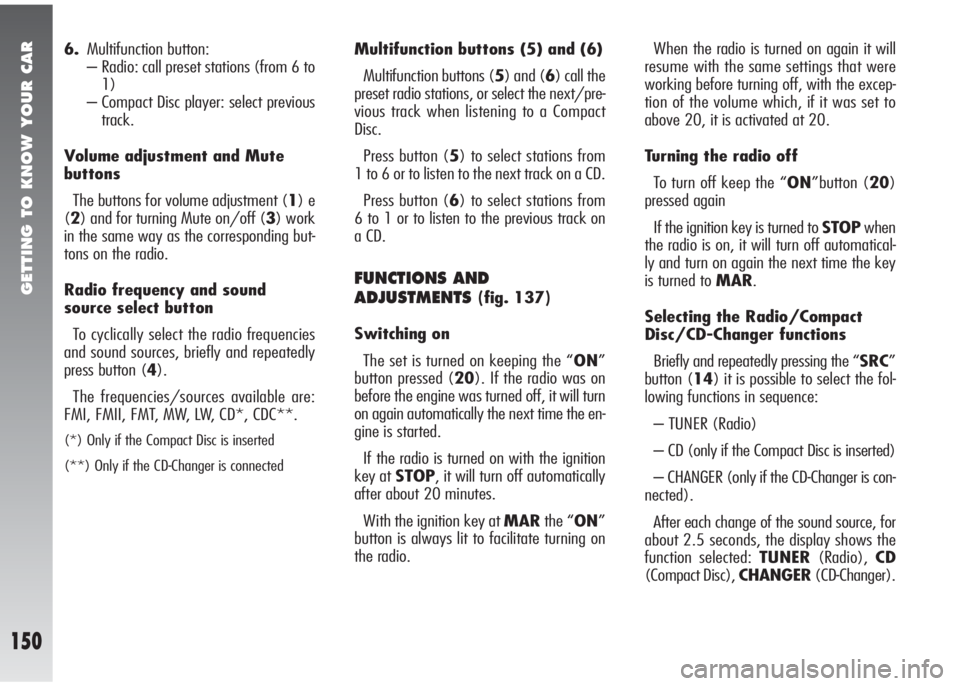
GETTING TO KNOW YOUR CAR
150
6.Multifunction button:
– Radio: call preset stations (from 6 to
1)
– Compact Disc player: select previous
track.
Volume adjustment and Mute
buttons
The buttons for volume adjustment (1) e
(2) and for turning Mute on/off (3) work
in the same way as the corresponding but-
tons on the radio.
Radio frequency and sound
source select button
To cyclically select the radio frequencies
and sound sources, briefly and repeatedly
press button (4).
The frequencies/sources available are:
FMI, FMII, FMT, MW, LW, CD*, CDC**.
(*) Only if the Compact Disc is inserted
(**) Only if the CD-Changer is connected
Multifunction buttons (5) and (6)
Multifunction buttons (5) and (6) call the
preset radio stations, or select the next/pre-
vious track when listening to a Compact
Disc.
Press button (5) to select stations from
1 to 6 or to listen to the next track on a CD.
Press button (6) to select stations from
6 to 1 or to listen to the previous track on
a CD.
FUNCTIONS AND
ADJUSTMENTS
(fig. 137)
Switching on
The set is turned on keeping the “ON”
button pressed (20). If the radio was on
before the engine was turned off, it will turn
on again automatically the next time the en-
gine is started.
If the radio is turned on with the ignition
key at STOP, it will turn off automatically
after about 20 minutes.
With the ignition key at MARthe “ON”
button is always lit to facilitate turning on
the radio.When the radio is turned on again it will
resume with the same settings that were
working before turning off, with the excep-
tion of the volume which, if it was set to
above 20, it is activated at 20.
Turning the radio off
To turn off keep the “ON”button (20)
pressed again
If the ignition key is turned to STOPwhen
the radio is on, it will turn off automatical-
ly and turn on again the next time the key
is turned to MAR.
Selecting the Radio/Compact
Disc/CD-Changer functions
Briefly and repeatedly pressing the “SRC”
button (14) it is possible to select the fol-
lowing functions in sequence:
– TUNER (Radio)
– CD (only if the Compact Disc is inserted)
– CHANGER (only if the CD-Changer is con-
nected).
After each change of the sound source, for
about 2.5 seconds, the display shows the
function selected: TUNER(Radio),CD
(Compact Disc), CHANGER(CD-Changer).
Page 153 of 291
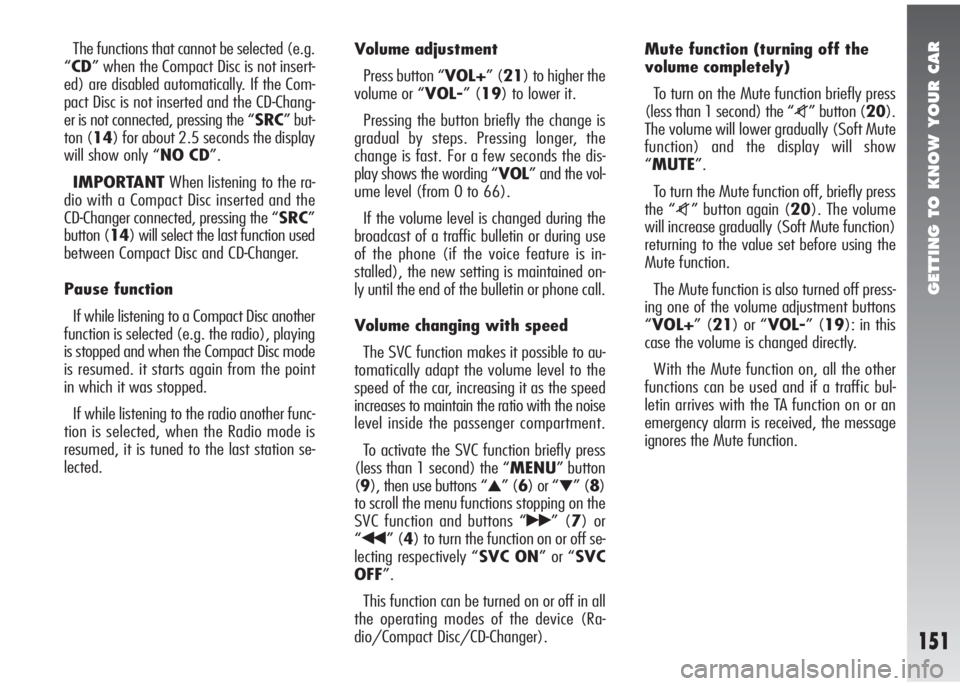
GETTING TO KNOW YOUR CAR
151
The functions that cannot be selected (e.g.
“CD” when the Compact Disc is not insert-
ed) are disabled automatically. If the Com-
pact Disc is not inserted and the CD-Chang-
er is not connected, pressing the “SRC” but-
ton (14) for about 2.5 seconds the display
will show only “NO CD”.
IMPORTANTWhen listening to the ra-
dio with a Compact Disc inserted and the
CD-Changer connected, pressing the “SRC”
button (14) will select the last function used
between Compact Disc and CD-Changer.
Pause function
If while listening to a Compact Disc another
function is selected (e.g. the radio), playing
is stopped and when the Compact Disc mode
is resumed. it starts again from the point
in which it was stopped.
If while listening to the radio another func-
tion is selected, when the Radio mode is
resumed, it is tuned to the last station se-
lected.Volume adjustment
Press button “VOL+” (21) to higher the
volume or “VOL-” (19) to lower it.
Pressing the button briefly the change is
gradual by steps. Pressing longer, the
change is fast. For a few seconds the dis-
play shows the wording “VOL” and the vol-
ume level (from 0 to 66).
If the volume level is changed during the
broadcast of a traffic bulletin or during use
of the phone (if the voice feature is in-
stalled), the new setting is maintained on-
ly until the end of the bulletin or phone call.
Volume changing with speed
The SVC function makes it possible to au-
tomatically adapt the volume level to the
speed of the car, increasing it as the speed
increases to maintain the ratio with the noise
level inside the passenger compartment.
To activate the SVC function briefly press
(less than 1 second) the “MENU” button
(9), then use buttons “
▲” (6) or “▼” (8)
to scroll the menu functions stopping on the
SVC function and buttons “
˙˙” (7) or
“
¯¯” (4) to turn the function on or off se-
lecting respectively “SVC ON” or “SVC
OFF”.
This function can be turned on or off in all
the operating modes of the device (Ra-
dio/Compact Disc/CD-Changer).Mute function (turning off the
volume completely)
To turn on the Mute function briefly press
(less than 1 second) the “
z” button (20).
The volume will lower gradually (Soft Mute
function) and the display will show
“MUTE”.
To turn the Mute function off, briefly press
the “
z” button again (20). The volume
will increase gradually (Soft Mute function)
returning to the value set before using the
Mute function.
The Mute function is also turned off press-
ing one of the volume adjustment buttons
“VOL+” (21) or “VOL-” (19): in this
case the volume is changed directly.
With the Mute function on, all the other
functions can be used and if a traffic bul-
letin arrives with the TA function on or an
emergency alarm is received, the message
ignores the Mute function.
Page 154 of 291
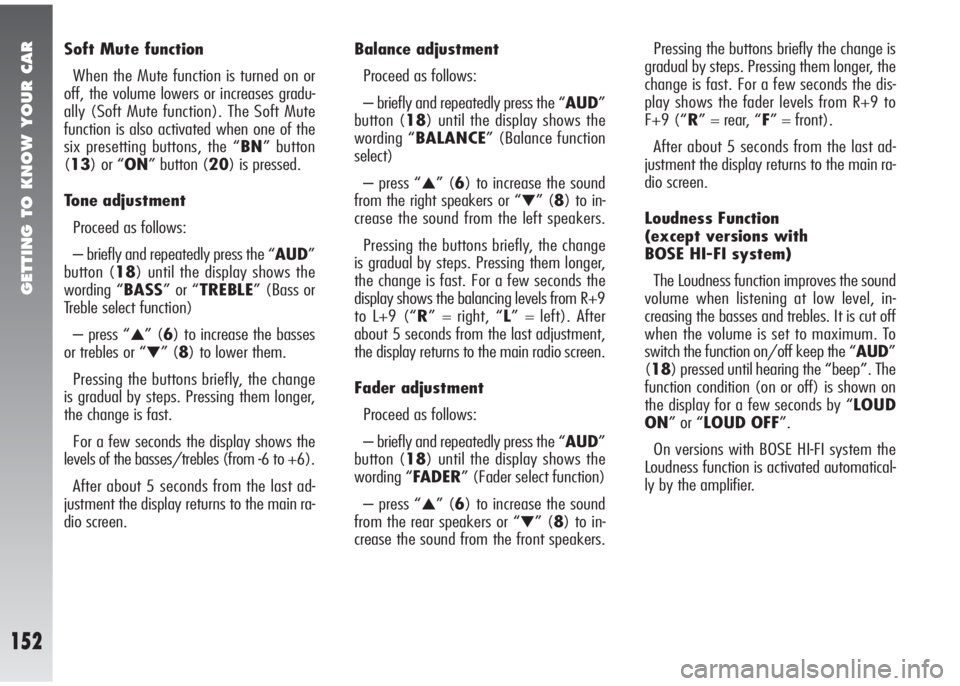
GETTING TO KNOW YOUR CAR
152
Soft Mute function
When the Mute function is turned on or
off, the volume lowers or increases gradu-
ally (Soft Mute function). The Soft Mute
function is also activated when one of the
six presetting buttons, the “BN” button
(13) or “ON” button (20) is pressed.
Tone adjustment
Proceed as follows:
– briefly and repeatedly press the “AUD”
button (18) until the display shows the
wording “BASS” or “TREBLE” (Bass or
Treble select function)
– press “
▲” (6) to increase the basses
or trebles or “
▼” (8) to lower them.
Pressing the buttons briefly, the change
is gradual by steps. Pressing them longer,
the change is fast.
For a few seconds the display shows the
levels of the basses/trebles (from -6 to +6).
After about 5 seconds from the last ad-
justment the display returns to the main ra-
dio screen. Balance adjustment
Proceed as follows:
– briefly and repeatedly press the “AUD”
button (18) until the display shows the
wording “BALANCE” (Balance function
select)
– press “
▲” (6) to increase the sound
from the right speakers or “
▼” (8) to in-
crease the sound from the left speakers.
Pressing the buttons briefly, the change
is gradual by steps. Pressing them longer,
the change is fast. For a few seconds the
display shows the balancing levels from R+9
to L+9 (“R” = right, “L” = left). After
about 5 seconds from the last adjustment,
the display returns to the main radio screen.
Fader adjustment
Proceed as follows:
– briefly and repeatedly press the “AUD”
button (18) until the display shows the
wording “FADER” (Fader select function)
– press “
▲” (6) to increase the sound
from the rear speakers or “
▼” (8) to in-
crease the sound from the front speakers.Pressing the buttons briefly the change is
gradual by steps. Pressing them longer, the
change is fast. For a few seconds the dis-
play shows the fader levels from R+9 to
F+9 (“R” = rear, “F” = front).
After about 5 seconds from the last ad-
justment the display returns to the main ra-
dio screen.
Loudness Function
(except versions with
BOSE HI-FI system)
The Loudness function improves the sound
volume when listening at low level, in-
creasing the basses and trebles. It is cut off
when the volume is set to maximum. To
switch the function on/off keep the “AUD”
(18) pressed until hearing the “beep”. The
function condition (on or off) is shown on
the display for a few seconds by “LOUD
ON” or “LOUD OFF”.
On versions with BOSE HI-FI system the
Loudness function is activated automatical-
ly by the amplifier.
Page 155 of 291

GETTING TO KNOW YOUR CAR
153
TELEPHONE PROVISION
(fig. 137)
If the voice kit is installed on the car, when
a phone call is received the radio sound is
connected to the phone input. The telephone
sound is heard with a fixed volume, but it
can be adjusted during the conversation us-
ing “VOL+” (21) to higher the volume or
“VOL-” (19) to lower it.
The fixed telephone volume can be ad-
justed through the “PHONE” function of
the menu (see“MENU” paragraph). The only buttons active during phone calls
are:
– “VOL+” (21), “VOL-” (19): for
volume adjustment
– “ON” (20): turning the radio on/off
– “AF-TA” (1): traffic information.
While the sound is off for a phone call, the
display shows the word “PHONE”.
The sound of the phone call will be inter-
rupted in the case of transmission of a traf-
fic bulletin or a PTY31 announcement; if
wishing to interrupt the bulletin press the
“AF-TA” button (1).
RADIO(fig. 137)
When the set is turned on the last function
selected before turning off is played (Radio,
Compact Disc or CD-Changer).
To select the Radio function while listening
to a Compact Disc, briefly and repeatedly
press the “SRC” button (14) until this
function is selected.
Selecting the frequency band
If in the Radio mode, briefly and repeat-
edly press the “BN” button (13) to select
the required reception band.
Every time the button is pressed the fol-
lowing bands are selected in sequence
“FM1”, “FM2”, “FMT”, “MW” and
“LW” shown by the respective wording on
the display.
The FM band is divided into section: FM1,
FM2 and FMT.
The FMT reception band is reserved to the
stations stored automatically with the Au-
tostore function.
The radio is always ready to receive sta-
tions in the RDS Mode (Radio Data System).
Page 156 of 291
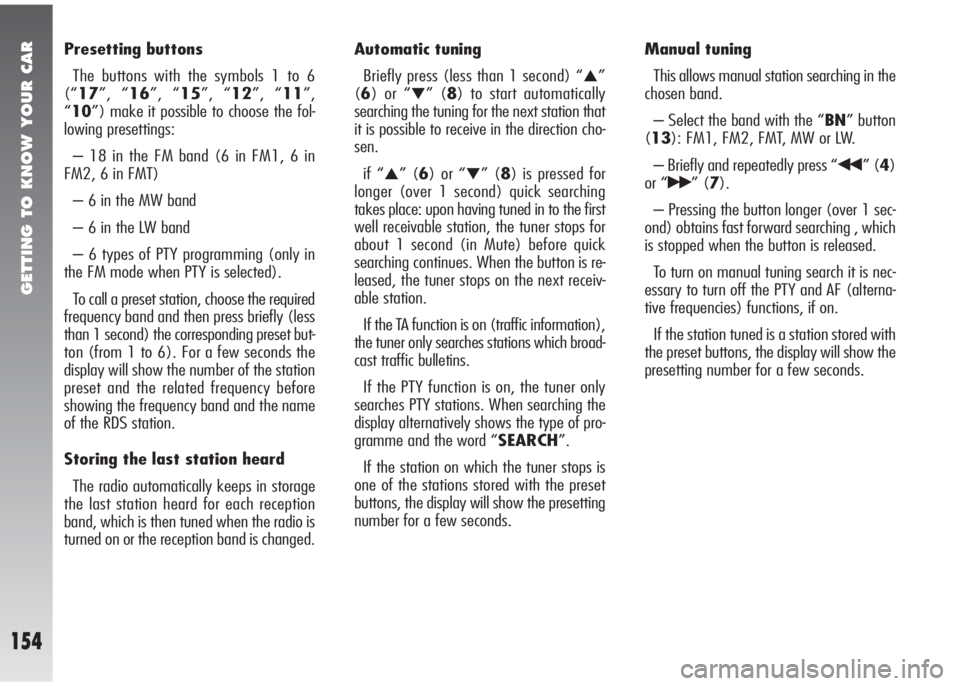
GETTING TO KNOW YOUR CAR
154
Presetting buttons
The buttons with the symbols 1 to 6
(“17”, “16”, “15”, “12”, “11”,
“10”) make it possible to choose the fol-
lowing presettings:
– 18 in the FM band (6 in FM1, 6 in
FM2, 6 in FMT)
– 6 in the MW band
– 6 in the LW band
– 6 types of PTY programming (only in
the FM mode when PTY is selected).
To call a preset station, choose the required
frequency band and then press briefly (less
than 1 second) the corresponding preset but-
ton (from 1 to 6). For a few seconds the
display will show the number of the station
preset and the related frequency before
showing the frequency band and the name
of the RDS station.
Storing the last station heard
The radio automatically keeps in storage
the last station heard for each reception
band, which is then tuned when the radio is
turned on or the reception band is changed.Automatic tuning
Briefly press (less than 1 second) “
▲”
(6) or “
▼” (8) to start automatically
searching the tuning for the next station that
it is possible to receive in the direction cho-
sen.
if “
▲” (6) or “▼” (8) is pressed for
longer (over 1 second) quick searching
takes place: upon having tuned in to the first
well receivable station, the tuner stops for
about 1 second (in Mute) before quick
searching continues. When the button is re-
leased, the tuner stops on the next receiv-
able station.
If the TA function is on (traffic information),
the tuner only searches stations which broad-
cast traffic bulletins.
If the PTY function is on, the tuner only
searches PTY stations. When searching the
display alternatively shows the type of pro-
gramme and the word “SEARCH”.
If the station on which the tuner stops is
one of the stations stored with the preset
buttons, the display will show the presetting
number for a few seconds.Manual tuning
This allows manual station searching in the
chosen band.
– Select the band with the “BN” button
(13): FM1, FM2, FMT, MW or LW.
– Briefly and repeatedly press “¯¯” (4)
or “
˙˙” (7).
– Pressing the button longer (over 1 sec-
ond) obtains fast forward searching , which
is stopped when the button is released.
To turn on manual tuning search it is nec-
essary to turn off the PTY and AF (alterna-
tive frequencies) functions, if on.
If the station tuned is a station stored with
the preset buttons, the display will show the
presetting number for a few seconds.